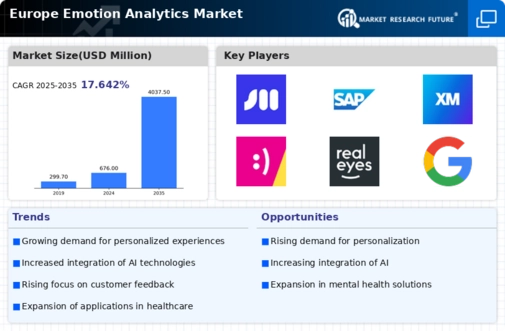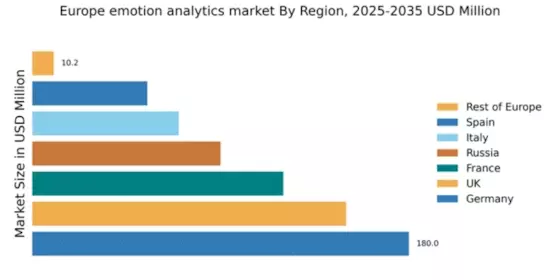Germany : Germany's Robust Growth and Innovation
Germany holds a dominant position in the European emotion analytics market, with a market value of $180.0 million, representing approximately 30% of the total market share. Key growth drivers include a strong emphasis on AI technology, increasing demand for customer insights, and supportive government initiatives promoting digital transformation. The regulatory environment is favorable, with policies encouraging innovation in data analytics and privacy protection, bolstering infrastructure development in tech hubs like Berlin and Munich.
UK : UK's Versatile Emotion Analytics Landscape
The UK emotion analytics market is valued at $150.0 million, accounting for about 25% of the European market. Growth is driven by the increasing adoption of AI in various sectors, including healthcare and marketing. The demand for personalized customer experiences is rising, supported by government initiatives aimed at enhancing digital skills. The regulatory framework is evolving, focusing on data protection and ethical AI use, which is crucial for market expansion.
France : France's Strategic Focus on Innovation
France's emotion analytics market is valued at $120.0 million, representing 20% of the European market. The growth is fueled by investments in AI research and development, alongside a strong push for digital transformation across industries. Government initiatives, such as the AI for Humanity strategy, are enhancing the regulatory landscape, promoting ethical AI practices. The demand for emotion analytics is particularly strong in sectors like retail and entertainment, where consumer engagement is critical.
Russia : Russia's Evolving Market Dynamics
Russia's emotion analytics market is valued at $90.0 million, making up about 15% of the European market. The growth is driven by increasing interest in AI technologies and their applications in various sectors, including security and marketing. Government initiatives are gradually supporting digital innovation, although regulatory challenges remain. The market is characterized by a mix of local and international players, with Moscow being a key hub for technology development and adoption.
Italy : Italy's Focus on Digital Transformation
Italy's emotion analytics market is valued at $70.0 million, representing around 12% of the European market. The growth is propelled by a rising demand for customer-centric solutions in retail and tourism. Government initiatives aimed at enhancing digital infrastructure and promoting AI adoption are crucial for market development. The competitive landscape includes both local startups and established international players, with cities like Milan leading in technology innovation and application.
Spain : Spain's Growing Market Potential
Spain's emotion analytics market is valued at $55.0 million, accounting for about 9% of the European market. The growth is driven by increasing investments in AI and a focus on enhancing customer experiences across sectors like retail and finance. Government policies promoting digitalization and innovation are fostering a supportive environment. The market is characterized by a mix of local and international companies, with Barcelona and Madrid being key centers for technology development.
Rest of Europe : Diverse Opportunities Across Regions
The Rest of Europe holds a smaller emotion analytics market valued at $10.25 million, representing about 2% of the total market. Growth is uneven, with varying levels of investment in AI technologies across different countries. Regulatory frameworks differ significantly, impacting market dynamics. Local demand is emerging in sectors like healthcare and education, but challenges remain in terms of infrastructure and awareness. Countries like Sweden and the Netherlands show potential for growth in this space.


















Leave a Comment